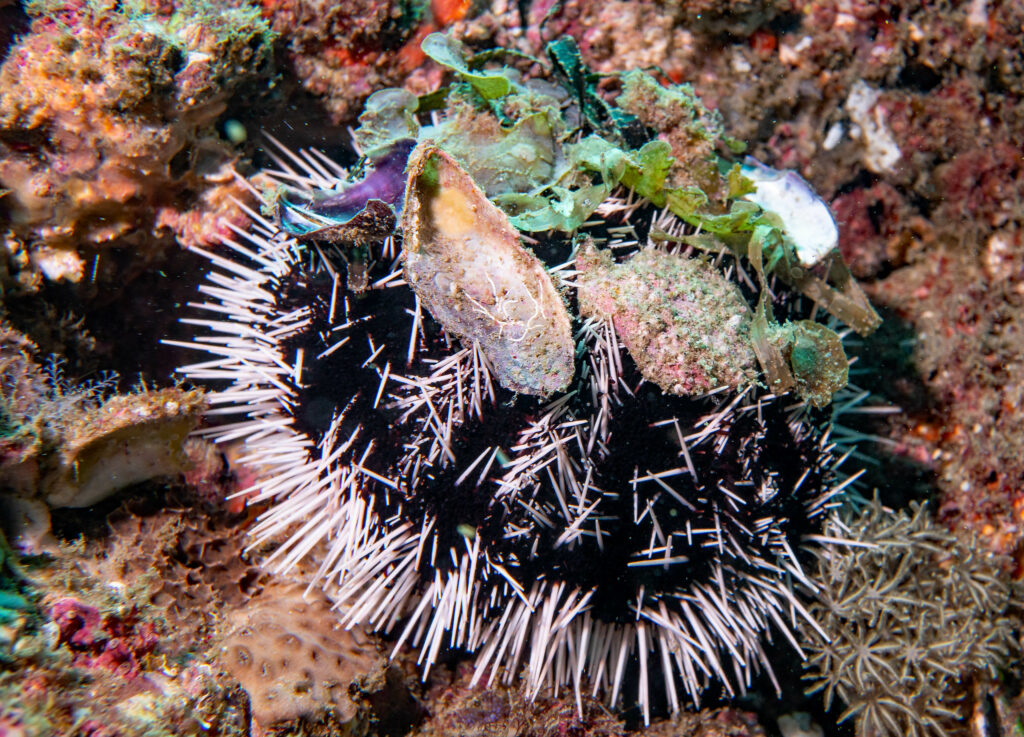Sydney-based RLS Trainer and Coordinator John Turnbull gets to the pointy end of Tripneustes identification trip-ups.
By RLS NSW Trainer and Coordinator John Turnbull
August 15, 2023
After three successive La Nina years, the NSW RLS team have been seeing some unusual changes in temperate kelp and urchin communities during surveys, drawing our attention to some changes in the ways we identify urchins in Australia.
During recent surveys around Sydney on Australia's east coast, the team noticed that shallow invertebrates and kelp were looking a bit different to previous years' surveys. Some sites are now full of fuzzy turfing algae where kelp once stood, and urchins are almost totally missing in some locations. At the same time, we saw record numbers of 'sea lamingtons' (
Tripneustes spp.) which are known for their boom and bust cycling.
Tripneustes are tropical-temperate urchins whose populations often boom and bust over time. These sea lamingtons are booming right now around Sydney, occupying space previously dominated by the long-spine urchin (
Centrostephanus rodgersii) and short-spined urchin (
Heliocidaris erythrogramma). Until recently, we called all of the
Tripneustes species in Sydney
Tripneustes gratilla, but emerging research has recently unpicked a more complex urchin story.
The tropical sea lamington species is still called
Tripneustes gratilla, and these urchins are characterised by a rounded, domed body shape, often orange spines, an underlying greenish tinge and banded tube feet (pictured above).
In more southern latitudes,
Tripneustes have a flatter body shape, often pure white spines on a chocolate brown body, and tube feet without banding (pictured below). These were re-classified in 2017 as
Tripneustes kermadecensis by researchers combining morphological and genetic analyses of
Tripneustes on the Kermadec Islands north-east of New Zealand. This species was deemed separate to
T. gratilla, and thought to be endemic to the Kermadec Islands. But that's not the end of the story..
In a 2019
article published in the journal
Marine Biology, Australian researchers identified local populations of '
T. kermadecensis', calling for further investigation into this species previously thought to be found only in the Kermadecs. An extensive search through museum samples found that these same local urchins were in fact identified long ago as "
australiae", and so there is now a manuscript in for review to reclassify
T. kermadecensis as
Tripneustes australiae (pers comm, Maria Byrne; manuscript: McLaren, E. et al, in review).
Whilst the name is therefore still tentative, it's important that we RLSers start to unpick the two species so we can separate them in our data. In recent surveys in Sydney, we've used
T. gratilla for the rounded, orange-spined, banded tube feet species, and
T. australiae for the brown-bodied, white spined "lamingtons". The latter are far more abundant, around 10 or 20
T. australiae for each
T. gratilla.
And just when we thought we had it sorted, we'd find a
hybrid or different colour morph. Note that, whilst this individual has orange spines, the tube feet are unbanded, so we've gone with
T. australiae.
We're also seeing
Centrostephanus rodgersii returning as juveniles, and the odd
Heliocardis erythrogramma too, so the
Tripneustes puzzle may not be around for much longer. With relatively weak spines and a pretty flaky camouflage strategy of hiding below scrappy bits of kelp and shells, I suspect they'll soon be eaten by Blueys or PJs. So, until the next boom... and in the meantime, we'll try not to get tripped up by misidentifying "Trips"!
Literature cited:
Maria Byrne; manuscript: McLaren, E. et al, in review








